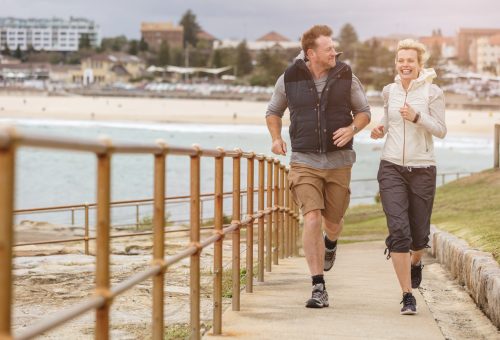
As we age it’s normal to lose muscle and gain fat. Can we do anything to slow this process down?
Move that body
As we age we lose muscle, which makes us less steady on our feet and more likely to fall. It can be a vicious cycle: you fall – you’re afraid of falling again so you’re less active – you lose muscle strength so you’re more likely to fall.
Less muscle also reduces our basal metabolic rate (BMR) – the rate we burn energy. The lower the BMR, the easier it is to gain fat. And the fat tends to go on around our stomach and internal organs, increasing the risk of diabetes, heart disease and high blood pressure. Not to mention ruining the look of our best clothes!
We tend to accept this as a normal part of aging but researchers have observed that people who keep vigorously active throughout their life have a similar body composition and physiological function to younger adults.
Even if you have been a couch potato, all is not lost. One study found that while people who had been physically active all their lives were about 60% less likely to have heart disease, even those lazy-bones who didn’t start serious exercise until after age 40 still had 55% less risk than those who stayed stuck in front of the television!
Regular exercise such as walking from the far side of the car park to the shops, taking the stairs instead of the lift, cycling with the grandchildren, swimming, dancing, golf, pilates and gardening have fantastic anti-aging effects.
It helps reduce high blood pressure, increases the good HDL cholesterol that takes fat away from the arteries, gets the bowel moving, keeps joints mobile (which helps with arthritis), keeps calcium in the bones so they stay strong, keeps muscles strong so you are less likely to fall, allows you to enjoy more food without gaining weight, and gives a boost of endorphins – the body’s natural mood improver.
Vitamin D
Just half an hour of activity outside each day is enough not only to keep reasonably fit and toned, but also to allow our skin to make its own vitamin D.
Vitamin D helps carry calcium into the bones to keep them strong. Not enough vitamin D and you are likely to have weak bones and muscles, and be more likely to fall.
Older people have about one-quarter the ability to produce vitamin D compared to younger people so it is important to get some sun exposure each day.
It’s the sun that causes the skin to make vitamin D. Sitting in a sunroom behind glass won’t do it. If at all possible, get up and take a walk around the garden for 30 minutes. Older people who can’t get outside each day may need a low-dose (10ug a day) vitamin D supplement.
As a rule it’s a good idea to check with your doctor before taking any supplement: some vitamins and minerals can be toxic at high doses; you also need to ensure there are no adverse interactions with any other drugs you may be on, now or in the future.
www.healthyfood.com










